Broadband Polarizing Beamsplitter Cubes in 30 mm Cage Cubes
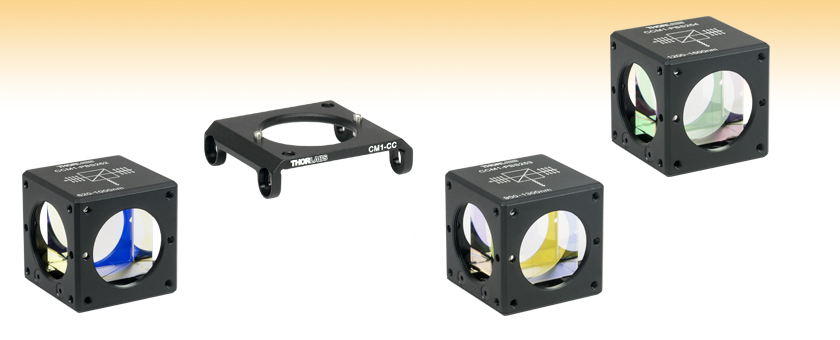
- Transmitted Beam Extinction Ratio: >1000:1
- Reflects S-Polarization 90º
- SM1 and 30 mm Cage System Compatible
- Engraved Housing
CCM1-PBS252
620 - 1000 nm
CM1-CC
CCM1-PBS253
900 - 1300 nm
CCM1-PBS254
1200 - 1600 nm

Please Wait
| Coating Range | Damage Threshold | |
|---|---|---|
| 420 - 680 nm | CWa | 350 W/cm at 532 nm, Ø1.000 mm |
| Pulse | 2 J/cm2 at 532 nm, 10 ns, 10 Hz, Ø0.803 mm | |
| 620 - 1000 nm | CWa | 50 W/cm at 810 nm, Ø0.019 mm |
| Pulse | 2 J/cm2 at 810 nm, 10 ns, 10 Hz, Ø0.166 mm | |
| 900 - 1300 nm | CWa,b | 1000 W/cm at 1070 nm, Ø0.971 mm |
| Pulse | 2 J/cm2 at 1064 nm, 10 ns, 10 Hz, Ø0.484 mm | |
| 1200 - 1600 nm | CWa,b | 1000 W/cm at 1540 nm, Ø1.030 mm |
| Pulse | 5 J/cm2 at 1542 nm, 10 ns, 10 Hz, Ø0.181 mm | |

Figure 1.1 Cube Beamsplitter Diagram
(Coating and Cement Layer Not to Scale)
Features
- 30 mm Cage and SM1 Lens Tube Compatible Mounts
- Wavelength Ranges from 420 to 1600 nm
- Extinction Ratio
- TP:TS > 1000:1
- RS:RP ~ 100:1
- Connect Two Cage Cubes Side by Side with the CM1-CC Cage Cube Connector
The polarizing beamsplitting cubes on this page have a dielectric coating along the diagonal interface between the two right angle prisms that make up the cube. This coating reflects s-polarized light, while transmitting p
For highest polarization purity, use the transmitted beam, which offers a 1000:1 (TP:TS) extinction ratio. The reflected beam will only have an extinction ratio of roughly 20:1 to 100:1, depending on the beamsplitter. All of the faces of this cube have broadband antireflective coatings that minimize losses due to reflections. The dielectric beamsplitting coating is applied to the hypotenuse of one of the two prisms that make up the cube. Then, cement is used to bind the two prism halves together (as shown in Figure 1.1). In order to achieve the desired 50:50 split ratio, the light can enter through any of the faces. One possible orientation is engraved on the top of the cage cube. Each beamsplitter cube is epoxied within the cage cube mount and cannot be removed from the mount. We also offer empty 30 mm cage cubes that are compatible with our line of unmounted beamsplitter cubes.
For a complete selection of our cube-mounted optics, please see the Mounted Optics Guide tab. For applications requiring a higher damage threshold, we offer high-power polarizing beamsplitting cubes. We also offer polarizing beamsplitter cubes at laser line wavelengths, which have a high extinction ratio of 3000:1 (TP:TS).
Thorlabs offers three types of mounted beamsplitters: Polarization Insensitive Beamsplitting Cubes, Polarizing Beamsplitting Cubes (presented below), and the Pellicle Beamsplitters. A large variety of unmounted beamsplitters are also available.
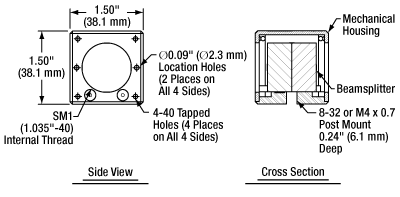
Click to Enlarge
Figure 2.1 Reference drawing for CCM1-PBS series cubes. The imperial versions have an 8-32 tap, whereas the metric versions have an M4 x 0.7 tap.
| Item # Suffix | PBS251(/M) | PBS252(/M) | PBS255(/M) | PBS253(/M) | PBS254(/M) |
|---|---|---|---|---|---|
| AR-Coating Range | 420 - 680 nm | 620 - 1000 nm | 700 - 1300 nm | 900 - 1300 nm | 1200 - 1600 nm |
| AR Coating (0° Incident Angle) |
Ravg < 0.5% | Ravg < 0.5% | Ravg < 1.0% | Ravg < 0.5% | Ravg < 0.5% |
| Ports | 4 Ports With SM1 (1.035"-40) Threads | ||||
| Beamsplitter Material | N-SF1 | ||||
| Extinction Ratioa | TP:TS > 1000:1 | ||||
| Transmission Efficiencyb |
TP > 90% | ||||
| Reflection Efficiencyb | RS, avg > 95% | ||||
| Transmitted Beam Deviationc |
0° ± 5 arcmin | ||||
| Reflected Beam Deviationd |
90° ± 20 arcmin | ||||
| Clear Aperture | >Ø20.32 mm | ||||
| Transmitted Wavefront Error |
<λ/4 at 633 nm over Ø20.32 mm | ||||
| Surface Quality | 40-20 Scratch-Dig | ||||
The shaded regions in the graphs below denote the transmission bands of the beamsplitters for which the performance is guaranteed to meet the stated specifications. Performance outside the shaded regions will vary from lot to lot and is not guaranteed.
Beamsplitter Selection Guide
Thorlabs' portfolio contains many different kinds of beamsplitters, which can split beams by intensity or by polarization. We offer plate and cube beamsplitters, though other form factors exist, including pellicle and birefringent crystal. For an overview of the different types and a comparison of their features and applications, please see our overview. Many of our beamsplitters come in premounted or unmounted variants. In this tab is a complete listing of our beamsplitter offerings. To explore the available types, wavelength ranges, splitting/extinction ratios, transmission, and available sizes for each beamsplitter category, click More [+] in the appropriate row.Plate Beamsplitters
| Non-Polarizing Plate Beamsplitters |
|---|
| Polarizing Plate Beamsplitters |
|---|
Cube Beamsplitters
| Non-Polarizing Cube Beamsplitters |
|---|
| Polarizing Cube and Polyhedron Beamsplitters |
|---|
Pellicle Beamsplitters
| Non-Polarizing Pellicle Beamsplitters |
|---|
Crystal Beamsplitters
| Polarizing Crystal Beamsplitters |
|---|
Other
| Other Beamsplitters |
|---|
30 mm Cage-Cube-Mounted Optics Selection Guide
The table below provides links to all of our 30 mm Cage-Cube-Mounted optics. For our selection of 16 mm Cage-Cube-Mounted Optics, please see our 16 mm Cage Systems guide.
30 mm Cage Cube Empty Optic Mounts Selection Guide
 |
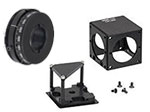 |
| Rectangular Dichroic Mirrors and Filters | Empty Compact 30 mm Cage Cube |
| Table 6.1 Specifications | ||
|---|---|---|
| Coating Range | Damage Threshold | |
| 420 - 680 nm | CWa | 350 W/cm at 532 nm, Ø1.000 mm |
| Pulse | 2 J/cm2 at 532 nm, 10 ns, 10 Hz, Ø0.803 mm | |
| 620 - 1000 nm | CWa | 50 W/cm at 810 nm, Ø0.019 mm |
| Pulse | 2 J/cm2 at 810 nm, 10 ns, 10 Hz, Ø0.166 mm | |
| 900 - 1300 nm | CWa,b | 1000 W/cm at 1070 nm, Ø0.971 mm |
| Pulse | 2 J/cm2 at 1064 nm, 10 ns, 10 Hz, Ø0.484 mm | |
| 1200 - 1600 nm | CWa,b | 1000 W/cm at 1540 nm, Ø1.030 mm |
| Pulse | 5 J/cm2 at 1542 nm, 10 ns, 10 Hz, Ø0.181 mm | |
Damage Threshold Data for Thorlabs' Polarizing Beamsplitter Cubes
The specifications in Table 6.1 are measured data for Thorlabs' polarizing beamsplitter cubes. Damage threshold specifications are constant for a given wavelength range, regardless of the size of the beamsplitter.
Laser Induced Damage Threshold Tutorial
The following is a general overview of how laser induced damage thresholds are measured and how the values may be utilized in determining the appropriateness of an optic for a given application. When choosing optics, it is important to understand the Laser Induced Damage Threshold (LIDT) of the optics being used. The LIDT for an optic greatly depends on the type of laser you are using. Continuous wave (CW) lasers typically cause damage from thermal effects (absorption either in the coating or in the substrate). Pulsed lasers, on the other hand, often strip electrons from the lattice structure of an optic before causing thermal damage. Note that the guideline presented here assumes room temperature operation and optics in new condition (i.e., within scratch-dig spec, surface free of contamination, etc.). Because dust or other particles on the surface of an optic can cause damage at lower thresholds, we recommend keeping surfaces clean and free of debris. For more information on cleaning optics, please see our Optics Cleaning tutorial.
Testing Method
Thorlabs' LIDT testing is done in compliance with ISO/DIS 11254 and ISO 21254 specifications.
First, a low-power/energy beam is directed to the optic under test. The optic is exposed in 10 locations to this laser beam for 30 seconds (CW) or for a number of pulses (pulse repetition frequency specified). After exposure, the optic is examined by a microscope (~100X magnification) for any visible damage. The number of locations that are damaged at a particular power/energy level is recorded. Next, the power/energy is either increased or decreased and the optic is exposed at 10 new locations. This process is repeated until damage is observed. The damage threshold is then assigned to be the highest power/energy that the optic can withstand without causing damage. A histogram such as that shown in Figure 37B represents the testing of one BB1-E02 mirror.

Figure 37A This photograph shows a protected aluminum-coated mirror after LIDT testing. In this particular test, it handled 0.43 J/cm2 (1064 nm, 10 ns pulse, 10 Hz, Ø1.000 mm) before damage.

Figure 37B Example Exposure Histogram used to Determine the LIDT of
| Table 37C Example Test Data | |||
|---|---|---|---|
| Fluence | # of Tested Locations | Locations with Damage | Locations Without Damage |
| 1.50 J/cm2 | 10 | 0 | 10 |
| 1.75 J/cm2 | 10 | 0 | 10 |
| 2.00 J/cm2 | 10 | 0 | 10 |
| 2.25 J/cm2 | 10 | 1 | 9 |
| 3.00 J/cm2 | 10 | 1 | 9 |
| 5.00 J/cm2 | 10 | 9 | 1 |
According to the test, the damage threshold of the mirror was 2.00 J/cm2 (532 nm, 10 ns pulse, 10 Hz, Ø0.803 mm). Please keep in mind that these tests are performed on clean optics, as dirt and contamination can significantly lower the damage threshold of a component. While the test results are only representative of one coating run, Thorlabs specifies damage threshold values that account for coating variances.
Continuous Wave and Long-Pulse Lasers
When an optic is damaged by a continuous wave (CW) laser, it is usually due to the melting of the surface as a result of absorbing the laser's energy or damage to the optical coating (antireflection) [1]. Pulsed lasers with pulse lengths longer than 1 µs can be treated as CW lasers for LIDT discussions.
When pulse lengths are between 1 ns and 1 µs, laser-induced damage can occur either because of absorption or a dielectric breakdown (therefore, a user must check both CW and pulsed LIDT). Absorption is either due to an intrinsic property of the optic or due to surface irregularities; thus LIDT values are only valid for optics meeting or exceeding the surface quality specifications given by a manufacturer. While many optics can handle high power CW lasers, cemented (e.g., achromatic doublets) or highly absorptive (e.g., ND filters) optics tend to have lower CW damage thresholds. These lower thresholds are due to absorption or scattering in the cement or metal coating.

Figure 37D LIDT in linear power density vs. pulse length and spot size. For long pulses to CW, linear power density becomes a constant with spot size. This graph was obtained from [1].

Figure 37E Intensity Distribution of Uniform and Gaussian Beam Profiles
Pulsed lasers with high pulse repetition frequencies (PRF) may behave similarly to CW beams. Unfortunately, this is highly dependent on factors such as absorption and thermal diffusivity, so there is no reliable method for determining when a high PRF laser will damage an optic due to thermal effects. For beams with a high PRF both the average and peak powers must be compared to the equivalent CW power. Additionally, for highly transparent materials, there is little to no drop in the LIDT with increasing PRF.
In order to use the specified CW damage threshold of an optic, it is necessary to know the following:
- Wavelength of your laser
- Beam diameter of your beam (1/e2)
- Approximate intensity profile of your beam (e.g., Gaussian)
- Linear power density of your beam (total power divided by 1/e2 beam diameter)
Thorlabs expresses LIDT for CW lasers as a linear power density measured in W/cm. In this regime, the LIDT given as a linear power density can be applied to any beam diameter; one does not need to compute an adjusted LIDT to adjust for changes in spot size, as demonstrated in Figure 37D. Average linear power density can be calculated using this equation.

This calculation assumes a uniform beam intensity profile. You must now consider hotspots in the beam or other non-uniform intensity profiles and roughly calculate a maximum power density. For reference, a Gaussian beam typically has a maximum power density that is twice that of the uniform beam (see Figure 37E).
Now compare the maximum power density to that which is specified as the LIDT for the optic. If the optic was tested at a wavelength other than your operating wavelength, the damage threshold must be scaled appropriately. A good rule of thumb is that the damage threshold has a linear relationship with wavelength such that as you move to shorter wavelengths, the damage threshold decreases (i.e., a LIDT of 10 W/cm at 1310 nm scales to 5 W/cm at 655 nm):

While this rule of thumb provides a general trend, it is not a quantitative analysis of LIDT vs wavelength. In CW applications, for instance, damage scales more strongly with absorption in the coating and substrate, which does not necessarily scale well with wavelength. While the above procedure provides a good rule of thumb for LIDT values, please contact Tech Support if your wavelength is different from the specified LIDT wavelength. If your power density is less than the adjusted LIDT of the optic, then the optic should work for your application.
Please note that we have a buffer built in between the specified damage thresholds online and the tests which we have done, which accommodates variation between batches. Upon request, we can provide individual test information and a testing certificate. The damage analysis will be carried out on a similar optic (customer's optic will not be damaged). Testing may result in additional costs or lead times. Contact Tech Support for more information.
Pulsed Lasers
As previously stated, pulsed lasers typically induce a different type of damage to the optic than CW lasers. Pulsed lasers often do not heat the optic enough to damage it; instead, pulsed lasers produce strong electric fields capable of inducing dielectric breakdown in the material. Unfortunately, it can be very difficult to compare the LIDT specification of an optic to your laser. There are multiple regimes in which a pulsed laser can damage an optic and this is based on the laser's pulse length. The highlighted columns in Table 37F outline the relevant pulse lengths for our specified LIDT values.
Pulses shorter than 10-9 s cannot be compared to our specified LIDT values with much reliability. In this ultra-short-pulse regime various mechanics, such as multiphoton-avalanche ionization, take over as the predominate damage mechanism [2]. In contrast, pulses between 10-7 s and 10-4 s may cause damage to an optic either because of dielectric breakdown or thermal effects. This means that both CW and pulsed damage thresholds must be compared to the laser beam to determine whether the optic is suitable for your application.
| Table 37F Laser Induced Damage Regimes | ||||
|---|---|---|---|---|
| Pulse Duration | t < 10-9 s | 10-9 < t < 10-7 s | 10-7 < t < 10-4 s | t > 10-4 s |
| Damage Mechanism | Avalanche Ionization | Dielectric Breakdown | Dielectric Breakdown or Thermal | Thermal |
| Relevant Damage Specification | No Comparison (See Above) | Pulsed | Pulsed and CW | CW |
When comparing an LIDT specified for a pulsed laser to your laser, it is essential to know the following:

Figure 37G LIDT in energy density vs. pulse length and spot size. For short pulses, energy density becomes a constant with spot size. This graph was obtained from [1].
- Wavelength of your laser
- Energy density of your beam (total energy divided by 1/e2 area)
- Pulse length of your laser
- Pulse repetition frequency (prf) of your laser
- Beam diameter of your laser (1/e2 )
- Approximate intensity profile of your beam (e.g., Gaussian)
The energy density of your beam should be calculated in terms of J/cm2. Figure 37G shows why expressing the LIDT as an energy density provides the best metric for short pulse sources. In this regime, the LIDT given as an energy density can be applied to any beam diameter; one does not need to compute an adjusted LIDT to adjust for changes in spot size. This calculation assumes a uniform beam intensity profile. You must now adjust this energy density to account for hotspots or other nonuniform intensity profiles and roughly calculate a maximum energy density. For reference a Gaussian beam typically has a maximum energy density that is twice that of the 1/e2 beam.
Now compare the maximum energy density to that which is specified as the LIDT for the optic. If the optic was tested at a wavelength other than your operating wavelength, the damage threshold must be scaled appropriately [3]. A good rule of thumb is that the damage threshold has an inverse square root relationship with wavelength such that as you move to shorter wavelengths, the damage threshold decreases (i.e., a LIDT of 1 J/cm2 at 1064 nm scales to 0.7 J/cm2 at 532 nm):

You now have a wavelength-adjusted energy density, which you will use in the following step.
Beam diameter is also important to know when comparing damage thresholds. While the LIDT, when expressed in units of J/cm², scales independently of spot size; large beam sizes are more likely to illuminate a larger number of defects which can lead to greater variances in the LIDT [4]. For data presented here, a <1 mm beam size was used to measure the LIDT. For beams sizes greater than 5 mm, the LIDT (J/cm2) will not scale independently of beam diameter due to the larger size beam exposing more defects.
The pulse length must now be compensated for. The longer the pulse duration, the more energy the optic can handle. For pulse widths between 1 - 100 ns, an approximation is as follows:

Use this formula to calculate the Adjusted LIDT for an optic based on your pulse length. If your maximum energy density is less than this adjusted LIDT maximum energy density, then the optic should be suitable for your application. Keep in mind that this calculation is only used for pulses between 10-9 s and 10-7 s. For pulses between 10-7 s and 10-4 s, the CW LIDT must also be checked before deeming the optic appropriate for your application.
Please note that we have a buffer built in between the specified damage thresholds online and the tests which we have done, which accommodates variation between batches. Upon request, we can provide individual test information and a testing certificate. Contact Tech Support for more information.
[1] R. M. Wood, Optics and Laser Tech. 29, 517 (1998).
[2] Roger M. Wood, Laser-Induced Damage of Optical Materials (Institute of Physics Publishing, Philadelphia, PA, 2003).
[3] C. W. Carr et al., Phys. Rev. Lett. 91, 127402 (2003).
[4] N. Bloembergen, Appl. Opt. 12, 661 (1973).
| Posted Comments: | |
Elin Bloem
(posted 2022-11-29 11:14:02.5) Do you have a version of this with a 2" cube in a 60 mm cage cube? If not, what do I need to mount a 2" cube in a 60 mm cage cube myself? cdolbashian
(posted 2022-12-02 04:11:36.0) Thank you for reaching out to us Elin! While we do not have a singular product which can achieve this at this time, I have reached out to you with some component parts which can create a comparable component. 郭乾坤 郭
(posted 2021-06-23 18:59:30.887) 您好,我想问下使用该PBS测试所得TE与TM的偏振模式的能量是否有损耗?
一般来说,(TE+TM)功率=总功率。
但我用该PBS测试所得TE与TM的偏振模式的功率相加不等于总功率,主要偏振态为TE的光,(TE+TM)功率损失大概有10%,主要偏振态为TM的光,(TE+TM)功率损失大概有5%。 YLohia
(posted 2021-06-28 11:21:42.0) Hello, thank you for contacting Thorlabs. An applications engineer from our team in China (techsupport-cn@thorlabs.com) will reach out to you directly. Wenzel Jakob
(posted 2020-06-05 06:46:40.433) I was wondering if Thorlabs can provide bounds on the angular deviation of the transmitted beam's linear polarization relative to the horizontal axis of the cube housing?
My goal is to use this cube to establish a reliable horizontal polarization axis that is aligned with a 30mm cage system. But for this, it would be good to know the actual tolerances. Thank you! YLohia
(posted 2020-06-12 09:06:25.0) Thank you for contacting Thorlabs. Unfortunately, we do not have a specific tolerance on the deviation of the transmitted beam relative to the horizontal axis of the housing. That being said, we have reached out to you directly to suggest a setup to measure this for your beamsplitter using a polarimeter. hongjin Li
(posted 2020-01-20 15:26:49.26) I hope some Zemax simulation which includes this PBS.
Could you offer some PBS-zemax documents or give me some suggestion ? nbayconich
(posted 2020-01-21 01:50:13.0) Thank you for contacting Thorlabs. We currently do not have Zemax files for our PBS cubes. We will reach out to you directly to help discuss your application. a1133195
(posted 2018-10-11 23:06:25.783) What is the performance of the CCM1-PBS254/M at 2000nm? YLohia
(posted 2018-10-15 10:42:15.0) Hello, the out-of-band performance at this wavelength varies between different production runs since this is quite far out of the design range. I will reach out to you directly with some data. danielpwhite1993.dw
(posted 2018-06-25 15:21:51.49) Is there a PBS that would work from 405 to 532nm? YLohia
(posted 2018-06-25 10:49:21.0) We will reach out to you directly to look into the possibility of offering a customized solution. user
(posted 2018-03-31 12:33:04.263) Hi, could you tell me if the stated reflection extinction ratio applies to polarised or un-polarised input, .i.e. If highly linearly polarised light was input into the cube would it matter if you used the transmitted or reflected component? nbayconich
(posted 2018-04-11 02:53:21.0) Thank you for contacting Thorlabs. The extinction ratio specification for our polarization dependent beamsplitters is given assuming a linearly polarized input as a ratio of the maximum to minimum transmission. geosmith
(posted 2016-06-13 11:12:01.653) I would like to swap the polarization that is transmitted without rotating the entire cube since the only mount is on the bottom face.
Is it possible for the end user to access the beamsplitter cube and rotate it 90 degrees within the mount? besembeson
(posted 2016-06-15 09:43:05.0) Response from Bweh at Thorlabs USA: The cube is glued to the base so it is not advisable to do that as you risk damaging the cube. You could have the freedom to orient the cube as you desire if you consider a combination of the CM1-4ER and the PBS251. cagrikaan.akkan
(posted 2013-07-29 10:10:18.653) Dear Sir/Madam,
I have a problem with this specified item ( CM1-PBS251). Last weak i was trying to make an experiment and suddenly the beam splitter got burned. Althouhg it is written on your web page it can resist 2J/cm^2 at 532nm/10Hz/10ns, the beam splitter burned at an output energy of 0.2J (10Hz/10ns/532nm/9mm beam dia). As you can see the specification that i wrote here, even the laser intensity at the center of the beam (gaussian consideration) can not be higher than 1J/cm^2. Do you have any suggestion to recover our damage?
Kind Regards...
Cagri Kaan AKKAN tcohen
(posted 2013-08-01 10:18:00.0) Response from Tim at Thorlabs to Cagri: Thank you for contacting us. This stated damage threshold is based on tested energy density where the optic suffered no damage. If the optic has dust/dirt accumulation or the surface quality has been compromised, the power handling can be reduced. I will contact you directly so we can discuss your damage in more detail. |
Polarizer Selection Guide
Thorlabs offers a diverse range of polarizers, including wire grid, film, calcite, alpha-BBO, rutile, and beamsplitting polarizers. Collectively, our line of wire grid polarizers offers coverage from the visible range to the beginning of the Far-IR range. Our nanoparticle linear film polarizers provide extinction ratios as high as 100 000:1. Alternatively, our other film polarizers offer an affordable solution for polarizing light from the visible to the Near-IR. Next, our beamsplitting polarizers allow for use of the reflected beam, as well as the more completely polarized transmitted beam. Finally, our alpha-BBO (UV), calcite (visible to Near-IR), rutile (Near-IR to Mid-IR), and yttrium orthovanadate (YVO4) (Near-IR to Mid-IR) polarizers each offer an exceptional extinction ratio of 100 000:1 within their respective wavelength ranges.
To explore the available types, wavelength ranges, extinction ratios, transmission, and available sizes for each polarizer category, click More [+] in the appropriate row below.
| Wire Grid Polarizers |
|---|
| Film Polarizers |
|---|
| Beamsplitting Polarizers |
|---|
| alpha-BBO Polarizers |
|---|
| Calcite Polarizers |
|---|
| Quartz Polarizers |
|---|
| Magnesium Fluoride Polarizers |
|---|
| Yttrium Orthovanadate (YVO4) Polarizers |
|---|
| Rutile Polarizers |
|---|

| Item # | Transmission |
|---|---|
| CCM1-PBS251 CCM1-PBS251/M |
Click Here for Raw Data |
| CCM1-PBS252 CCM1-PBS252/M |
Click Here for Raw Data |
| CCM1-PBS255 CCM1-PBS255/M |
Click Here for Raw Data |
| CCM1-PBS253 CCM1-PBS253/M |
Click Here for Raw Data |
| CCM1-PBS254 CCM1-PBS254/M |
Click Here for Raw Data |
- Transmitted Extinction Ratio: TP:TS > 1000:1
- Transmission Efficiency: TP > 90%
- Four SM1-Threaded Ports
- 4-40 Tapped Holes for 30 mm Cage Systems
Our CCM1-PBS series of mounted polarizing beamsplitter cubes utilizes our 1" (25.4 mm) polarizing beamsplitter cubes. Each cube is mounted in a 30 mm cage system compatible housing, which also offers four SM1-threaded ports. In addition to offering cage and lens tube system compatibility, these cubes feature either an 8-32 or M4 tap on the bottom of each cube, making them post mountable.


Click to Enlarge
Figure 437B A C4W and C6W Cage Cube connected to a 1.5" wide
CCM1-4ER Compact Cage Cube using the C4W-CC and CM1-CC Cube Connectors, respectively.
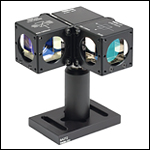
Click to Enlarge
Figure 437A CM1-CC Cage Cube Connector Connecting Multiple 1.5" Wide Cage Cubes
- Connect Two 1.5" Wide Cage Cubes Side by Side
- Connect a 1.5" Wide Cage Cube to a 2" Wide Cage Cube
- Compatible with CM1 or CCM1 Series Cage Cubes
The CM1-CC cage cube connector allows two or more CM1 or CCM1 style cubes to be connected as shown in Figure 437A. The CM1 and CCM1 series of cage cubes, which are all compatible with this connector, include empty cubes, empty dichroic cubes, mounted beamsplitters, mounted penta prisms, and mounted turning mirrors. The CM1-CC cage cube connector includes four 4-40 button-head screws, two 4-40 flat-head screws, four washers, and a 1/16" hex key.
Two cage cube-mounted turning mirrors cannot be connected using the CM1-CC due to a lack of Ø6 mm cage rod holes on two sides of the cube.
We also offer the C4W-CC to connect two 2" wide 30 mm cage cubes. Both C4W-CC and CM1-CC cage cube connectors can be used to connect one 1.5" wide 30 mm cage cube, such as our CCM1-4ER(/M), with a 2" wide 30 mm cage cube.
Alignment Pins
Please note that because dowel alignment pins are used, the connector requires drilled holes on the cube face between the SM1-threaded (1.035"-40) ports. If you have an older cube and would like it updated to have alignment holes for free, please contact Technical Support. Alternatively, the alignment pins are press-fit inside their mounting holes, and can be pressed out for use with cubes that do not have these alignment holes.
 Products Home
Products Home


















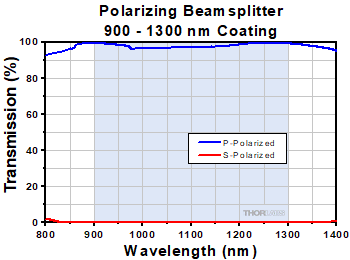


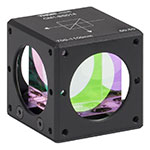

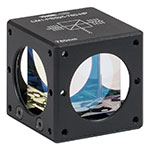
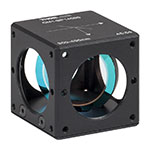
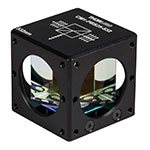
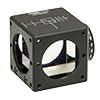
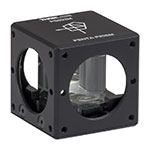
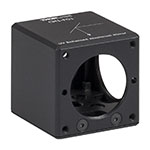
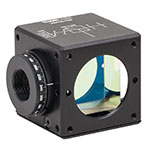
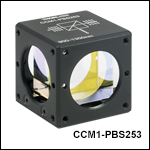
 Zoom
Zoom
 Mounted Beamsplitter Cubes
Mounted Beamsplitter Cubes